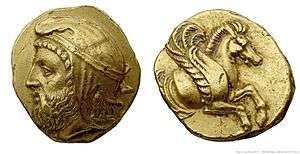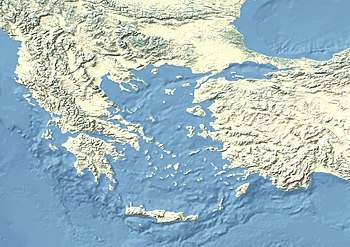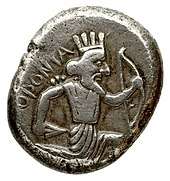Orontes I
Orontes I or Yervand I (Old Persian: *Arvanta-) was an Bactrian nobleman,[1] who ruled as satrap of the Achaemenid satrapy of Armenia from 401 to 344 BC. He is regarded as the ancestor of the Orontid dynasty.
| Orontes I | |||||
|---|---|---|---|---|---|
 Orontes I's portrait on the observe of a coin, showing him with the satrapal headdress | |||||
| Satrap of Sophene and Matiene | |||||
| Reign | 401 – 344 BC | ||||
| Coronation | 401 BC | ||||
| Predecessor | Artasyrus | ||||
| Successor | Darius III Codomannus | ||||
| Died | 344 BC Ionia | ||||
| Spouse | Rhodogoune | ||||
| Issue | Orontes II | ||||
| |||||
| House | Armavir | ||||
| Dynasty | Orontid Dynasty | ||||
| Father | Artasyrus | ||||
| Mother | Asatera | ||||
Biography
Satrap of Armenia
Orontes was a son of the Bactrian[2][3] Artasyrus. Orontes has therefore sometimes been referred to as "Orontes the Bactrian",[2][4] According to the Greek sources (Xenophon, Strabo), Orontes was made Satrap of Sophene and Matiene (Mitanni).[5] He was called "Praefectus Armeniae" by Trogus.[6]
Battle of Cunaxa (401 BC)
Orontes was given these Satrapies of Armenis in 401 BC for supporting the Persian king Artaxerxes II in the Battle of Cunaxa against Cyrus the Younger. After the Battle of Cunaxa, Orontes harassed the Ten Thousand as they attempted to return home and made their way through Armenia.[7] It is likely he ruled from Armavir as the previous Satrap of Armenia, Hydarnes, had ruled from there. He married Rhodogoune, the daughter of king Artaxerxes II by one of his concubines.[8]
Cyprus campaign (381 BC)

He next appears in 381 BC as the army commander during the campaign to recapture Cyprus from its rebel leader, King Evagoras, whilst the navy was under the command of Tiribazus. They managed to lay siege to the city of Salamis; however, Orontes intrigued against Tiribazus before king Artaxerxes II, but this led to Orontes falling from favor. It may be because of this that he was stripped of his satrapy and sent to the west of the Empire to become satrap of Mysia..
Satrap of Mysia

In 362 BC a great rebellion occurred in Anatolia, led by Datames, Satrap of Cappadocia (Revolt of the Satraps). Some sources say that it was Orontes who was chosen by the rebels as their leader. However, Orontes stayed loyal to king Artaxerxes II and aided in the collapse of the rebellion. Apparently, he wanted to rule Anatolia and Armenia alone. He captured the city of Pergamon and sent bribes to Athens, where a decree seeking an alliance records his name. He was able to fund these activities as he is recorded as having a personal fortune of 3,000 talents of silver.
From around 362-361, Orontes is said to be "Satrap of Mysia", and there is various proof of his activity in the region and around Pergamon.[9][10]
In 355 BC he rebelled against the new king of the Achaemenid Empire, Artaxerxes III. He still had possession of parts of western Anatolia. He fought a battle against the satrap of Daskyleion and minted his own coins in Ionia, such as the one displayed in the Bibliothèque Nationale in Paris. He handed back Pergamon to the king.
The kings of the Kingdom of Commagene claimed descent from Orontes I and also claimed Darius I of Persia as an ancestor, thanks to Orontes' marriage to Rhodogoune, daughter of Artaxerxes II who was a direct descendant of king Darius I.[11][12]
Xenophon's Anabasis mentions that the region near the river Centrites was defended by the Satrap of Armenia for Artaxerxes II and named Orontes son of Artasyrus who had Armenian contingents. Xenophon mentioned that he had a son called Tigranes. His successor was Darius III and after Codomannus these Satrapies were ruled by Orontes II. Whether he was the same person as Tigranes but had adopted the name Orontes or that they were brothers is not known.
Coinage
All the known coinage of Orontes is confined to the region of Mysia, and was only found in cities from Lampsacus to Colophon, particularly Adramyteion and Kisthene in the area of Aeolis on the coast.[13]
References
- Schmitt 2002.
- Gershevitch 1985, p. 354.
- Chahin 2001, p. 185.
- Chahin, M. (2001). The Kingdom of Armenia: A History. Psychology Press. p. 185. ISBN 978-0700714520.
(...) son of Artasyras, the "King's Eye", sometimes called "Orontes the Bactrian". because of his princely, Bactrian parentage.
- Petrie, Flinders. Mitannian (Armenian) origin
- Stylianou, P. J.; Stylianou, Research Associate P. J. (1998). A Historical Commentary on Diodorus Siculus. Clarendon Press. p. 530. ISBN 9780198152392.
- Xen. Anab. 2.4-5 passim
- Plutarch. Life of Artaxerxes.
- Briant, Pierre (2002). From Cyrus to Alexander: A History of the Persian Empire. Eisenbrauns. p. 662. ISBN 9781575061207.
- Stylianou, P. J.; Stylianou, Research Associate P. J. (1998). A Historical Commentary on Diodorus Siculus. Clarendon Press. p. 532. ISBN 9780198152392.
- Cook, J.M. (1993). The Persian Empire ([Repr.] ed.). New York: Barns & Noble Books. pp. 170, 173, 193, 212, 213, 216, 217, 221–223, 257, 263. ISBN 1-56619-115-7.
- The Armenian People from Ancient to Modern Times - 2 Vols., Richard G. Hovannisian, St. Martin's Press, New York, 1997
- Stylianou, P. J.; Stylianou, Research Associate P. J. (1998). A Historical Commentary on Diodorus Siculus. Clarendon Press. p. 532. ISBN 9780198152392.
Sources
- Osborne, Michael J. (1973). "Orontes". Historia: Zeitschrift für Alte Geschichte. 22 (4): 515–551. ISSN 0018-2311. JSTOR 4435366.
- Osborne, Michael J. (1971). "Athens and Orontes". Annual of the British School at Athens. 66: 297–321. doi:10.1017/S0068245400019213. ISSN 2045-2403. JSTOR 30103238.
- Hyla A., Troxell (1981). "Orontes, Satrap of Mysia". Schweizerische Numismatische Rundschau. 60: 27–41. ISSN 0035-4163.
- Garsoian, Nina (2004). "Armeno-Iranian Relations in the pre-Islamic period". Encyclopaedia Iranica.CS1 maint: ref=harv (link)
- Schmitt, Rüdiger (2002). "Orontes". Encyclopaedia Iranica.CS1 maint: ref=harv (link)
- Chahin, M. (2001). The Kingdom of Armenia: A History. Psychology Press. ISBN 978-0700714520.CS1 maint: ref=harv (link)
- Gershevitch, Ilya, ed. (1985). The Cambridge History of Iran, Volume 2: The Median and Achaemenian periods. Cambridge University Press. ISBN 978-0521200912.CS1 maint: ref=harv (link)
| Wikimedia Commons has media related to Orontes I. |